PIPING PLOVER

The Piping Plover is a small (6-7 inches long) whitish plover the color of dry sand. It has a narrow black band above the forehead which reaches from eye to eye, a complete or incomplete dark ring around the neck, and yellow legs. In summer, the bill is yellow with a dark tip. In winter bill and legs are dark.
Piping Plovers are rare migrants through Kansas. They require sparsely vegetated shallow wetlands and open beaches and sandbars adjacent to or within streams and impoundments. Nesting has been recorded on sand bars along the Kansas River. Piping Plovers may occur occasionally anywhere in the state where suitable habitat is found. The marked counties are the only ones for which observation records are known.

Piping Plovers are protected by the Kansas Nongame and Endangered Species Conservation Act, the Federal Endangered Species Act, and state and federal regulations applicable to those acts. Any time an eligible project is proposed that will impact the species’ preferred habitats within its probable range, the project sponsor must contact the Ecological Services Section, Kansas Department of Wildlife, Parks and Tourism, 512 SE 25th Ave., Pratt, Kansas 67124-8174. Department personnel can then advise the project sponsor on permit requirements under Kansas’ statutes. Sponsors of projects impacting Piping Plover habitats must also contact the Endangered Species Specialist, U.S.
Fish and Wildlife Service, 315 Houston Street, Suite E, Manhattan, Kansas 66502.
As defined by Kansas Administrative Regulations, critical habitats include those areas documented as currently supporting self-sustaining population(s) of any threatened or endangered species of wildlife as well as those areas determined by the Kansas Department of Wildlife, Parks and Tourism to be essential for the conservation of any threatened or endangered species of wildlife.
Currently, the following areas are designated critical for Piping Plovers:
All the waters within a corridor along the main stem of the Kansas River from the confluence of the Smoky Hill River and Republican River on Fort Riley in Geary County to the confluence of the Missouri River in Kansas City, Wyandotte County.
The U.S. Fish and Wildlife Service has authority to designate areas of critical habitat for federally listed threatened species, but has not done so for Piping Plovers in Kansas.
Geary
Jefferson
Johnson
Leavenworth
Pottawatomie
Riley
Shawnee
Wabaunsee
Wyandotte







